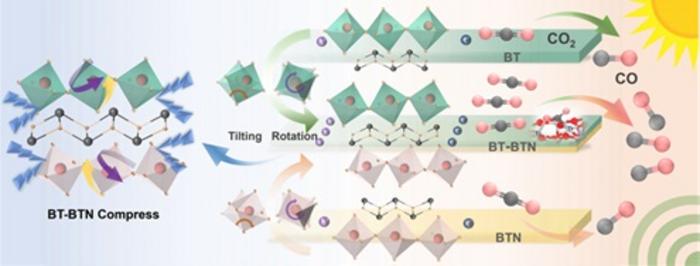
In the realm of advanced materials, the quest for efficient piezo-photocatalysts has witnessed groundbreaking research, especially in the domain of intergrowth ferroelectric semiconductors. Recent investigations reveal that these materials possess intrinsic spontaneous polarization electric fields that significantly enhance charge carrier separation and migration. This vital characteristic positions them as promising candidates for piezo-photocatalytic applications, particularly in the reduction of carbon dioxide—a paramount goal in addressing environmental concerns.
A team of researchers from China and Singapore has published compelling findings in the journal Advanced Powder Materials that illuminate the mechanisms behind the high-performance capabilities of intergrowth piezo-photocatalysts. Their focus revolves around the material Bi₇Ti₄NbO₂₁, a ferroelectric semiconductor whose unique properties stem from its structural characteristics. The study emphasizes how the manipulation of the material’s structure can lead to increased ferroelectric polarization, facilitating enhanced photocatalytic activity.
The synthesis of Bi₇Ti₄NbO₂₁ was achieved through a one-step hydrothermal method, a significant advancement over traditional high-temperature solid-state processes. This innovative approach resulted in the production of two-dimensional nanosheets, which displayed superior mechanical force sensitivity and a larger specific surface area compared to their bulk counterparts. This increased surface area is particularly critical as it provides more active sites for chemical reactions, thereby augmenting the material’s efficacy in CO₂ reduction.
The researchers noted that the intergrowth structure of Bi₇Ti₄NbO₂₁ nanosheets induces a stronger remanent polarization compared to parent phases such as Bi₃TiNbO₉ and Bi₄Ti₃O₁₂. This heightened polarization effectively enhances the electric fields generated under mechanical stress, improving the separation and migration of charge carriers—a crucial factor for efficient photocatalytic processes. The findings assert that the geometry of these nanosheets plays an integral role in their functionality, as the structural composition facilitates a favorable environment for charge dynamics.
Density functional theory (DFT) calculations further elucidate the unique characteristics of the Bi₇Ti₄NbO₂₁ structure. This material exhibits a multi-layer superlattice architecture, where alternating layers of (Bi₂O₂)²⁺ and perovskite-like (BiTiNbO₇)²⁻ create a complex lattice. These structural features demand a degree of adjustment within the octahedral units, resulting in self-tilting and self-rotation phenomena. Such structural adaptations have been shown to correlate strongly with enhanced polarization, thereby promoting a robust spontaneous polarization electric field.
The application of periodic mechanical stress is another determinant of piezoelectric performance. Researchers found that the two-dimensional thin-layer structure could generate larger strains, further amplifying tilting and rotation of the octahedra, which translates into a super-strong piezoelectric polarization electric field. This physical response not only optimizes the capture and activation of CO₂ molecules but also propels efficient charge transfer during photocatalytic reactions.
The experimental results indicate a substantial increase in CO generation rates from the Bi₇Ti₄NbO₂₁ nanosheets, achieving levels of 426.97 μmol g⁻¹ h⁻¹. This enhancement underscores the potential of these intergrowth ferroelectric materials in driving sustainable chemical processes. By optimizing structural properties and elucidating the underlying mechanisms, this research paves the way for the development of next-generation piezo-photocatalysts with applications in environmental remediation and energy conversion.
Moreover, the implications of this research extend beyond laboratory settings. By harnessing the unique properties of Bi₇Ti₄NbO₂₁, scientists envision numerous real-world applications, including carbon capture technologies that could effectively mitigate climate change impacts. The innovative synthesis methods and detailed characterization pave the way for scalability and potential commercialization of such materials.
In summary, the recent study elucidates the significant advancements in the field of piezo-photocatalysis through a deeper understanding of ferroelectric materials. The findings present a compelling narrative for material scientists and environmental researchers alike, highlighting the intricate connections between structure, property, and performance. The potential to leverage these insights for practical applications stands as a testament to the significant strides made in materials science.
The pursuit of sustainable energy solutions hinges not only on the development of new materials but also on comprehending the fundamental science that governs their characteristics. As researchers continue to explore the depths of intergrowth ferroelectric semiconductors, the future looks promising for innovative materials capable of addressing some of the most pressing environmental challenges of our time.
Through interdisciplinary collaborations and innovative research approaches, the scientific community is on the brink of discovering materials that can redefine energy conversion processes. The story of Bi₇Ti₄NbO₂₁ serves as a beacon of hope, charting a path toward a more sustainable and efficient energy landscape that could transform global efforts in environmental conservation.
Subject of Research: Not applicable
Article Title: Structure-Tailored Superlattice Bi₇Ti₄NbO₂₁: Coupling Octahedral Tilting and Rotation Induced High Ferroelectric Polarization for Efficient Piezo-photocatalytic CO₂ Reduction.
News Publication Date: Not applicable
Web References: Not applicable
References: Not applicable
Image Credits: Jingren Ni, Hongjian Yu.
Keywords
Materials science, Chemistry, Physics, Piezo-photocatalysis, Ferroelectric semiconductors, Nanomaterials, Carbon dioxide reduction, Energy conversion, Structural tailoring, High-performance materials.
Tags: advanced piezo-photocatalysts researchBi₇Ti₄NbO₂₁ synthesis methodscharge carrier separation in ferroelectricsenvironmental applications of photocatalysisferroelectric polarization enhancementhydrothermal technique for nanosheetsintergrowth ferroelectric semiconductorsmaterials science innovationsmechanical force sensitivity in photocatalystsphotocatalytic carbon dioxide reductionstructural optimization in piezo-photocatalysistwo-dimensional ferroelectric materials





